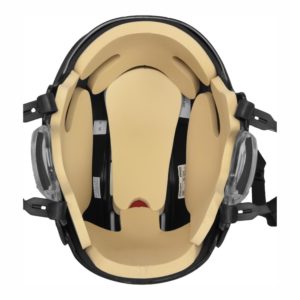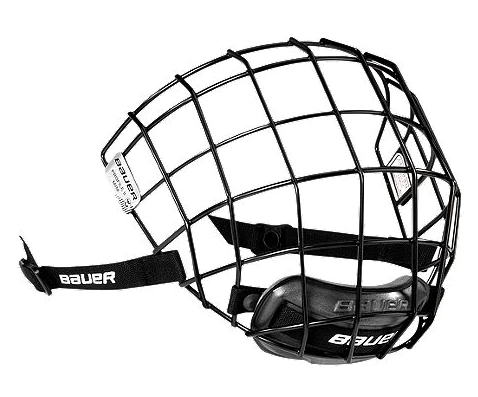HELMETS (AND FULL-CAGES)
Hockey helmets, as you can imagine, are the most important piece of protective equipment you can purchase. So it goes without saying that while you can manage oversized shin pads or undersized shoulder pads, if your helmet doesn’t fit correctly, you are setting yourself up for a potentially traumatic injury.

That being said, it is most important to recognize that on the current retail scene, there is no “best” or “worst” helmet. There is only the helmet for the best fit for your head. This means that unless you have tried on and fitted a helmet, it is highly recommended that you do not purchase a helmet online or via catalog.
We recommend that all SPMHA players wear black helmets. This will ensure that your helmet matches the rest of your team and the SPMHA designated colors.
Price Range for Helmets
$60 to $299 for a helmet, $90 to $350 for a helmet with cage sold together, for a new, current model. While a late model helmet, or a helmet that is no longer in production, can be found new and be considered safe, it is highly recommended to avoid used helmets. Used helmets run the risk of decayed foams and stressed plastic that may not provide suitable protection.
Cheap Hockey Helmets vs High End Helmets
Helmets are basically dictated into two types: EPP (expanded polypropylene), and VN (Dual-density vinyl nitrile).
EPP foam is a harder, typically black foam, which you may know from bicycle helmets. It often looks like Styrofoam, with visible cells. Because of the rigidity, it is typically lined with softer foam, meant to more cradle the head and create a more snug fit. This type of foam is usually found in the higher price point helmets ranging from $100 – $200. These are typically more expensive helmets than their VN counterparts and will have more options for adjusting and fit.
VN helmets are lined with a softer foam, that can be pushed or pinched and visibly indented momentarily. This foam is typically tan, gray, or black, and is usually not accompanied by other types of foam. Helmets that utilize the VN foam are typically on the lower end of the price scale, usually $100 or less.
Common wisdom seems to trend towards the idea that EPP helmets are more protective than VN, but there is no reliable data to support that. Because of the slight give in VN helmets, the helmet usually offers a tigher and more secure fit to the head, whereas an EPP helmet may have the tendency to have gaps and slipping if not a perfect fit.


Most Popular Brands for Hockey Helmets
The major brands in helmets are Bauer and CCM with Warrior being a distant 3rd. In recent years, outlier brands such as Cascade, Mission, Jofa, have been absorbed by the larger brands as well as bigger brands like Easton and Reebok. Mission recently re-debuted its helmet line, and although the brand is now primarily focused on roller hockey, it’s helmets are certified safe for ice hockey.
Will my Helmet Prevent Concussions?
To stem a common misconception, a hockey helmet’s primary purpose is to prevent a skull fracture, not a concussion. A skull fracture or other blunt impact can be dissipated across the shells and foams of a helmet, but a concussion occurs due to rotational forces. What this means is, if your head moves rapidly, such as in a whiplash situation, a concussion may occur even without any impact to the head. While helmet companies have dedicated themselves to creating helmets designed to prevent concussions, the results are not fully known or proven.
Another important point on helmets is that it is the only piece of equipment where the used market should not be considered a viable option. Ebay, Craigslist and Play it Again stores should not be pursued for a hockey helmet, as the certifications are often void on resale. This could be an issue if a head injury is sustained, which may negate the insurance of both the helmet manufacturer and the hockey governing body that offers insurance, such as USA Hockey.
How Should a Hockey Helmet Fit?
In a word, tight. While the style may be for a low hanging chin strap, this is dangerous. The Chin strap should be no more than the width of two fingers below the chin, to make sure the helmet does not come off during a fall, leaving the head and brain unprotected.
The helmet itself should be tight enough that it won’t shake loose when you shake your head up and down or side to side. To adjust the fit the adjustment tabs or screws on the helmet should be loosened, the helmet placed on the head, and with both hands you should push the pieces of the helmet together until it is snug (will not move around). At that point, a teammate can tighten the screws or snap the adjustment tabs closed to maintain the ideal fit. Redness around the head is normal, and is preferential to a loose fitting hockey helmet.
The helmet should sit on or just above the brow line, and should feel snug at the crown, temples, the beginning of the neck, and the forehead. If significant gaps are felt, that helmet is not a proper fit and another option should be considered.
A good fit means the helmet is snug and does not move, shift or rotate while playing but is not so tight that it causes pain or discomfort.
How Are Helmets Sized?
Helmets typically are sized in adult small, medium, and large, as well as youth small, medium, and large. Occasionally, adult extra large and youth extra small helmets can be found.
It’s important to note that the sizing varies significantly from brand to brand, so head sizes that may be on the fringes between two sizes in one brand should be careful about buying another brand without trying it on first.
Expected Lifespan of Hockey Helmets
Every helmet comes with a sticker of certification from various associations. Most certifications are valid for five years of play (some for 6.5). Helmets should not be used beyond this lifespan, as the foams and plastics can degrade and the integrity of the helmet can be compromised, risking injury.
Note from Coach Jeremy: Just because the sticker says the helmet is good for 5 years does not mean the helmet will last that long. After a very hard impact a helmet may need to be replaced.
Full Face Cages
Cages are, of course, designed to protect the eyes and face from errant sticks and puck impacts, preventing cuts and broken bones. They are mandated by Hockey Canada for all players under the age of 18.
Cages are usually steel, but currently there is one Titanium option, offered by Bauer. Titanium, stronger and lighter than steel, offers a more comfortable option as well as extra protection. The biggest difference in the retail cage offerings are the size and shape of the steel.
Some of the most common and popular cage models are the CCM FM580, Bauer Re-akt and CCM Resistance. Players like the longer, straighter look over some of the more “bubbly” appearances of the Bauer cages, as well as the option of white, black, or chrome based on the player’s preference.
How to Size a Cage
A cage or combo can be used a size smaller than a helmet, such as a large helmet and medium cage, but the shield should not be a size up from the helmet. Most brands of cages and shields can fit on the helmets of their competitions, so mixing and matching is an option.
We recommend checking a cage / visor compatibility chart before purchasing.
Cage Expected Lifespan
A cage can be used for quite a long time, as long as it doesn’t begin to rust. A diligent owner who takes the helmet out of the bag to sit and dry after each skate can feel safe in a cage for over 10 years. Care should be taken to make sure rust and corrosion aren’t setting in on the joints, though.
Care & Maintenance of Helmets
The biggest issue you will have with helmets are screws coming loose or falling out. It doesn’t happen too often, but when it does you will need to fix it. It doesn’t hurt to carry a helmet repair kit in your bag. If you don’t need it during a season you can bet a guy on your team will so it is nice to have. (The one I linked to has a lot of different hardware that should be everything you need)
Helmets usually don’t require a lot of maintenance. Simply remove the helmet from the hockey bag after skating, to dry properly to protect screws and attachments from rust or corrosion.
Corroded screws can become difficult to adjust or remove, and the chin or cage strap closures often pull apart when corroded too badly. While this is easy and cheap to replace, it can be frustrating if it happens during a game or practice. If the chin strap or cage straps are not fastened properly, the player should not use the helmet until the pieces have been replaced.

